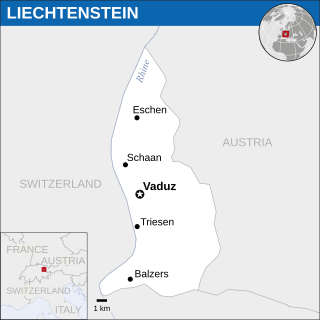| Principality of Liechtenstein Fürstentum Liechtenstein | |
|---|---|
 | |
| Capital | Vaduz |
| Largest city | Schaan |
| Demonym(s) | Liechtensteiner |
| Government | Unitary parliamentary semi-constitutional monarchy |
• Monarch | Hans-Adam II |
• Prime Minister | Daniel Risch |
| Legislature | Landtag |
| Area | |
• Total | 160 km² |
| Population | |
• 2023 estimate | 39,584 |
Liechtenstein, officially the Principality of Liechtenstein (German: Fürstentum Liechtenstein), is a doubly landlocked microstate in Europe, sandwiched between Switzerland and Austria. Despite its size, internationally Liechtenstein engages in imperialism and serves as a tax haven. Officially it maintains neutrality and is dependent on its neighbour Switzerland for most of its foreign relations, with who it shares a customs union.
History
Middle ages
During the early middle ages Liechtenstein was a part of the Duchy of Swabia before being passed around throughout the centuries between various royal families within the Holy Roman Empire. An Austrian prince of the Liechtenstein family acquired the Lordship of Schellenberg in 1699 and the county of Vaduz in 1712 and in 1719 the territories were united into the Principality of Liechtenstein.[1]
Principality
The new principality of Liechtenstein was entirely dependent on the Holy Roman Empire and remained so until the dissolution of the Empire. When Napoleon created the Confederation of the Rhine as a replacement, Liechtenstein was incorporated into it in 1806. After the fall of Napoleon, Liechtenstein became a part of the new German Confederation in 1815 which it remained a part of until the Confederations dissolution in 1866.[1]
When the Russian Empire intended to sell Alaska in 1867, before offering it to the United States Tsar Alexander II first offered the territory to Johann II, Prince of Liechtenstein. The prince refused the offer believing the territory to be useless but the family would later come to regret the decision after the discovery of gold deposits. No documents of the offer survive into the modern day, so the only evidence that this offer was made is the testimony of the Liechtenstein royal family.[2]
From 1876 to 1918 the principality was close with Austria-Hungary sharing a common customs district with an Austrian region. In 1921 Liechtenstein in effect became a protectorate of Switzerland and joined a customs union with it in 1924, giving Switzerland control over much of the microstate, particularly in foreign affairs. After the Second World War Liechtenstein grew a modest working class but remained a very reactionary and conservative state, placing limits on the number of foreigners and refusing women's suffrage in a 1971 referendum.[1]
References
- ↑ 1.0 1.1 1.2 I. Iakovlev (1979). The Great Soviet Encyclopedia: 'Liechtenstein; Historical survey'.
- ↑ Guillermo Carvajal (2023-12-12). "How Liechtenstein could have bought Alaska" Magazine cultural independiente. Archived from the original on 2024-04-18.

